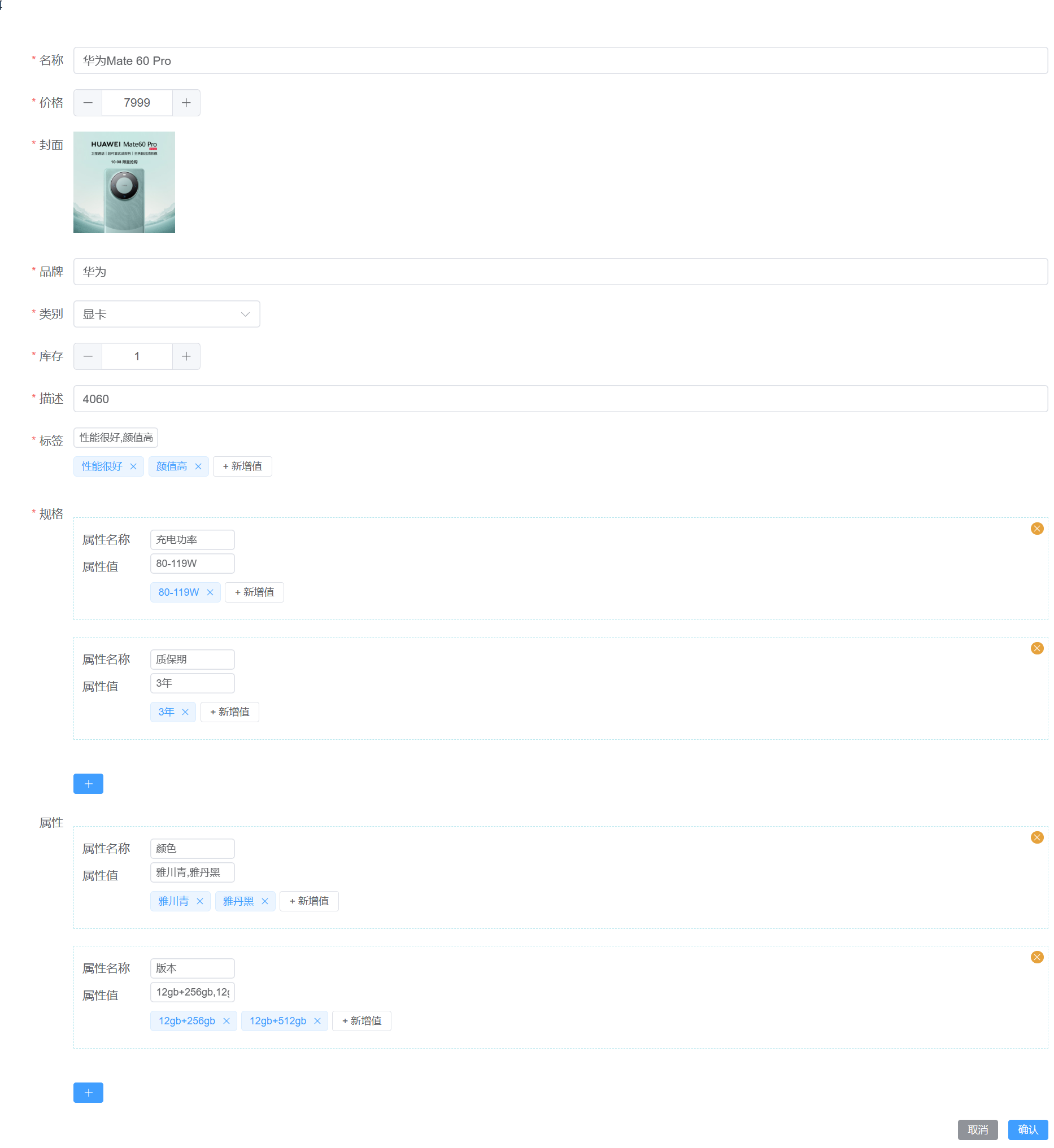商品管理
大约 2 分钟
商品管理

建表
-- auto-generated definition
create table product
(
id varchar(36) not null
primary key,
created_time datetime(6) not null,
edited_time datetime(6) not null,
creator_id varchar(36) not null,
editor_id varchar(36) not null,
name varchar(255) not null,
price decimal(10, 2) not null,
cover varchar(255) not null,
brand varchar(255) not null,
category_id varchar(36) not null,
stock int not null,
description text not null,
tags varchar(255) not null,
specifications text not null,
attributes text not null
);
实体类
对应前端传来的键值对.
@Data
public class KeyValue {
private String name;
private List<String> values;
}
在mysql数据库肯定是不支持键值对和列表的数据结构. 所以实际存储的时候会把键值对序列号成json字符串存储.
因此你可以看到表结构中tags,specifications,attributes都是属于字符型. 当是在java代码中它是string类型.
这种映射方式请参考jimmer中的json映射
@Entity
@GenEntity
public interface Product extends BaseEntity {
@GenField(value = "名称", order = 0)
String name();
@NotNull
@GenField(value = "价格", type = ItemType.INPUT_NUMBER, order = 1)
BigDecimal price();
@GenField(value = "封面", type = ItemType.PICTURE, order = 2)
String cover();
@GenField(value = "品牌", order = 3)
String brand();
@ManyToOne
ProductCategory category();
@IdView
@GenField(value = "类别", order = 4)
String categoryId();
@GenField(value = "库存", order = 5, type = ItemType.INPUT_NUMBER)
int stock();
@GenField(value = "描述", order = 6)
String description();
@GenField(value = "标签", order = 7)
@Serialized
List<String> tags();
@GenField(value = "规格", order = 8)
@Serialized
List<KeyValue> specifications();
@GenField(value = "属性", order = 9)
@Serialized
List<KeyValue> attributes();
}
相关信息
生成代码
参考开发流程
商品类别选择
修改Dto
Product.dto
input ProductInput {
#allScalars(Product)
// 接受categoryId
categoryId
id?
}
远程选择器
<el-form-item label="类别" prop="categoryId">
<remote-select
label-prop="name"
:query-options="categoryQueryOption"
v-model="createForm.categoryId"
></remote-select>
</el-form-item>
标签输入
<el-form-item label="标签" prop="tags">
<value-input v-model="createForm.tags"></value-input>
</el-form-item>
相关信息
规格输入
规格输入相当于购买商品时的参数. 如屏幕分别率: 1080p. 质保期: 3年. 等等这些比较杂的参数可以放在规格里面进行展示
在输入规格时相当于是输入键值对,值可以有多个.
<el-form-item label="规格" prop="specifications">
<key-value-input v-model="createForm.specifications"></key-value-input>
</el-form-item>
相关信息
属性输入
在我们购买商品时需要选择商品的属性后才会出现对应的价格,比如购买手机时选择 颜色: 黑色, 型号: 8gb+256gb.
上面的例子中,颜色和型号都是属于手机号的属性,每个属性可以对应多个值.当这些不同属性的值进行排列组合之后才是购买时的商品.
<el-form-item label="属性" prop="attributes">
<key-value-input v-model="createForm.attributes"></key-value-input>
</el-form-item>
相关信息
